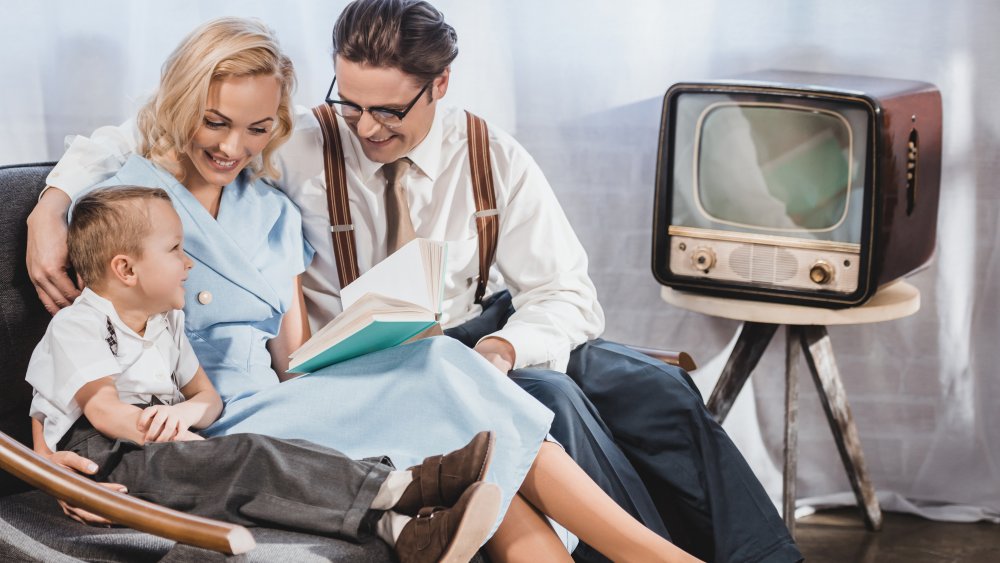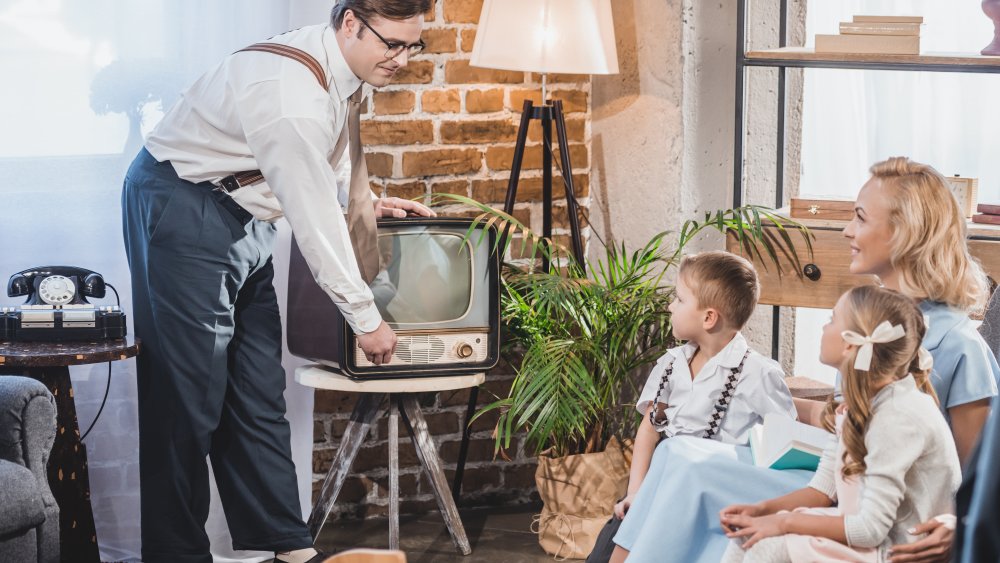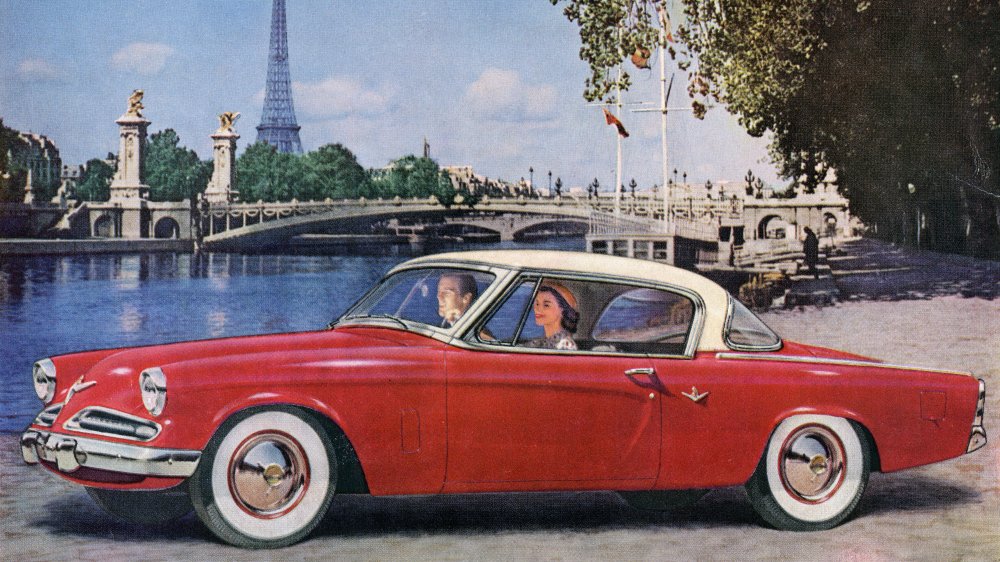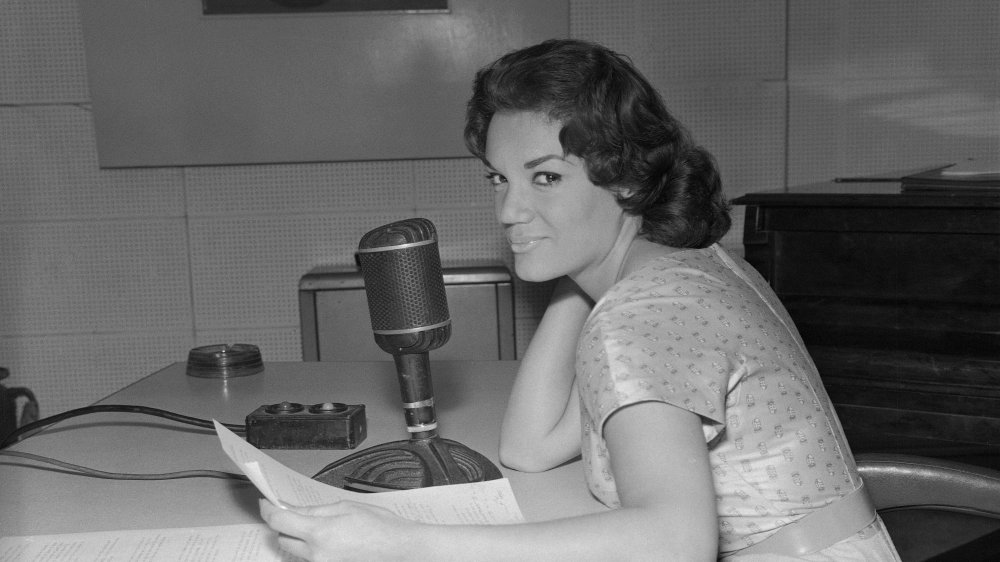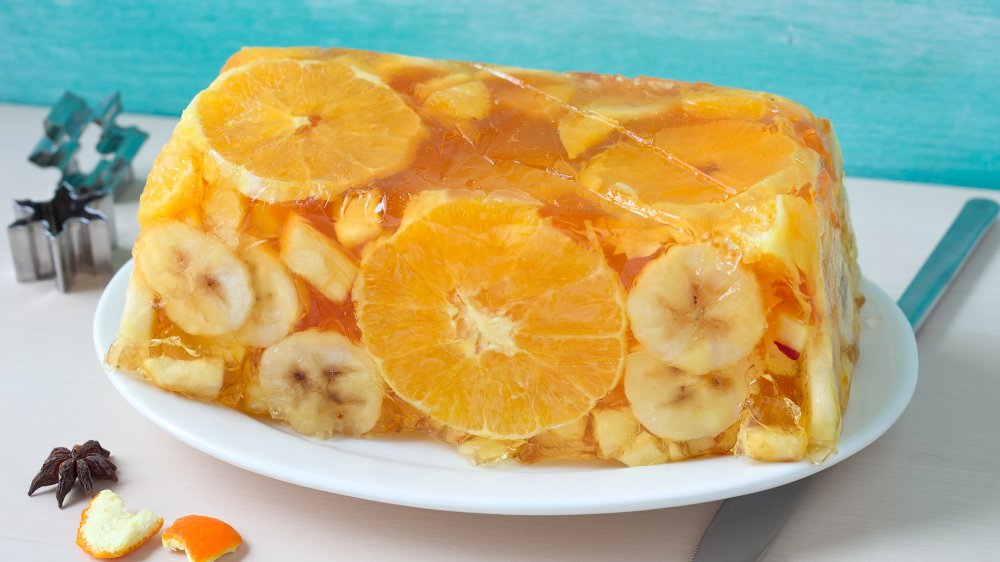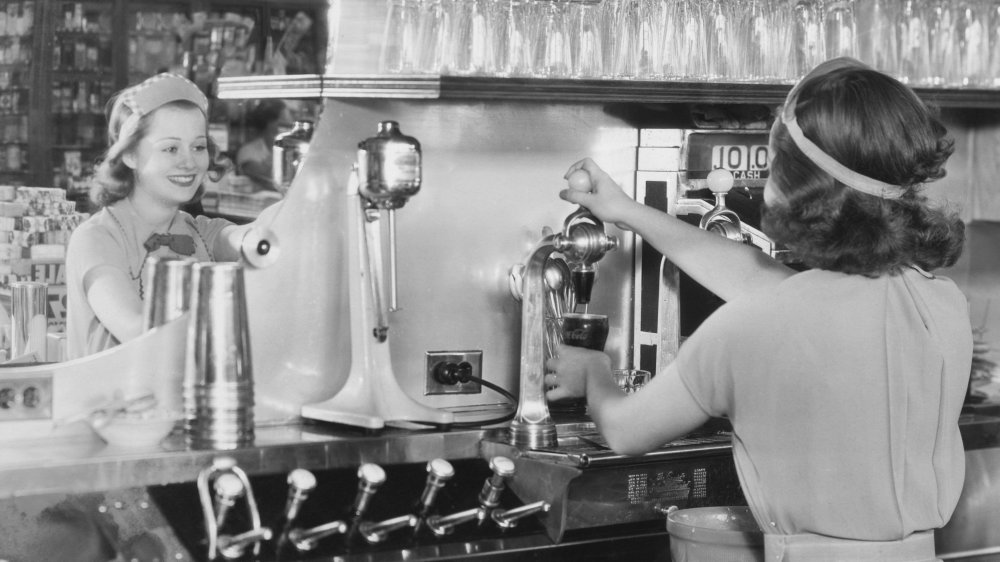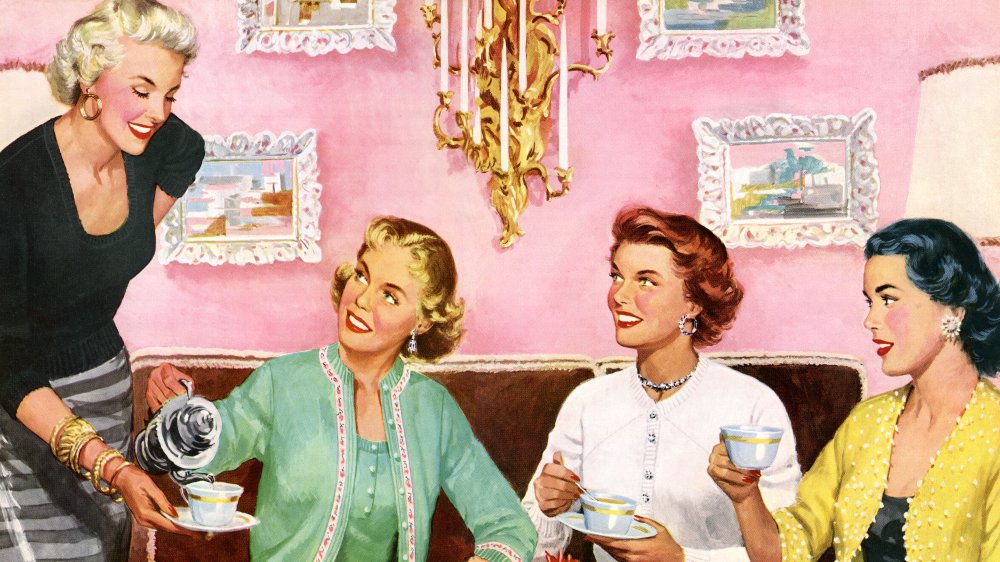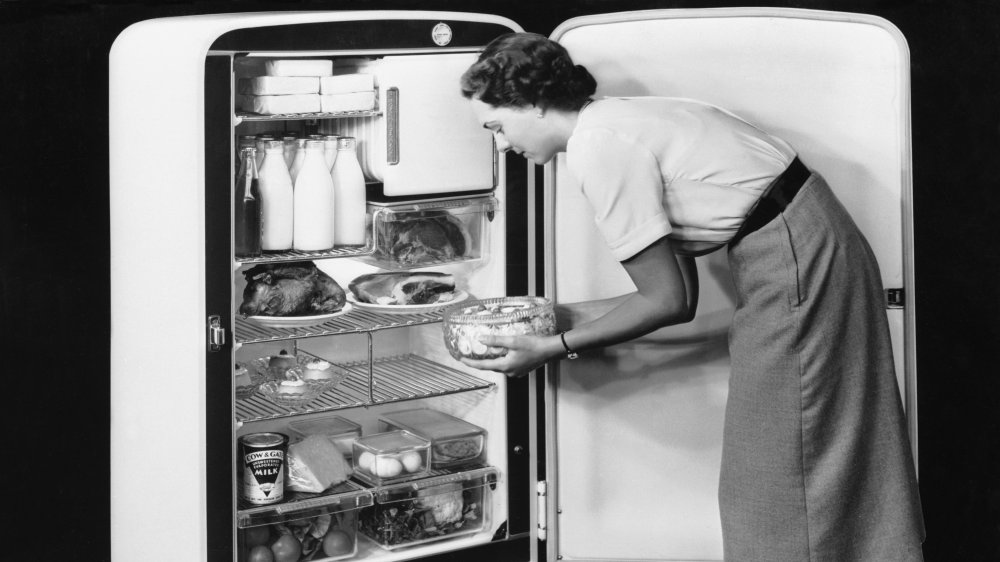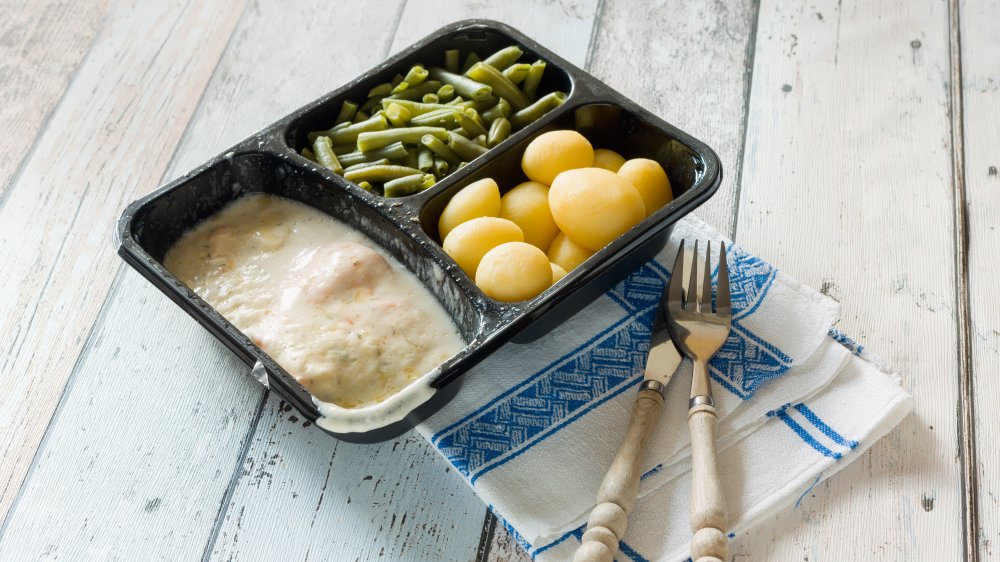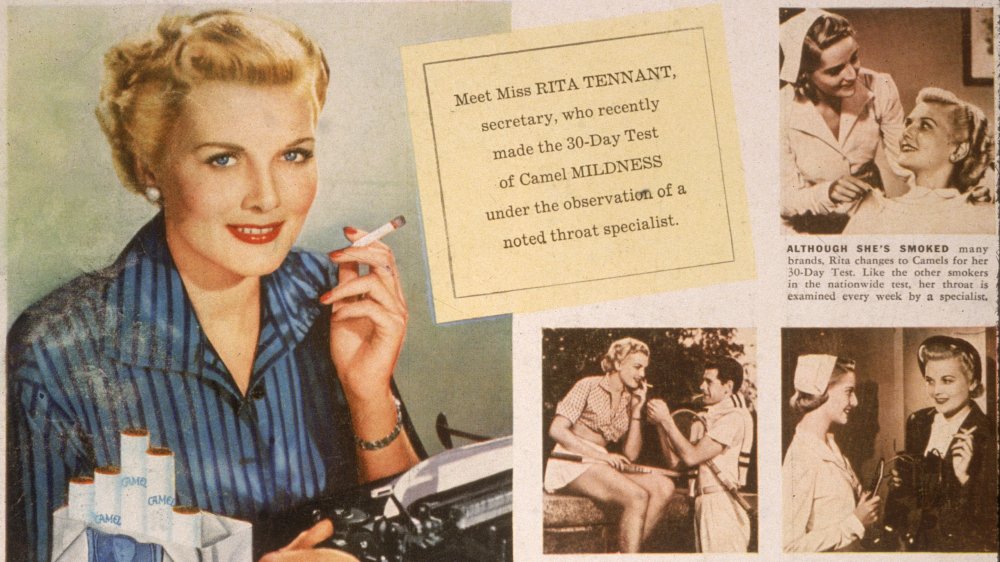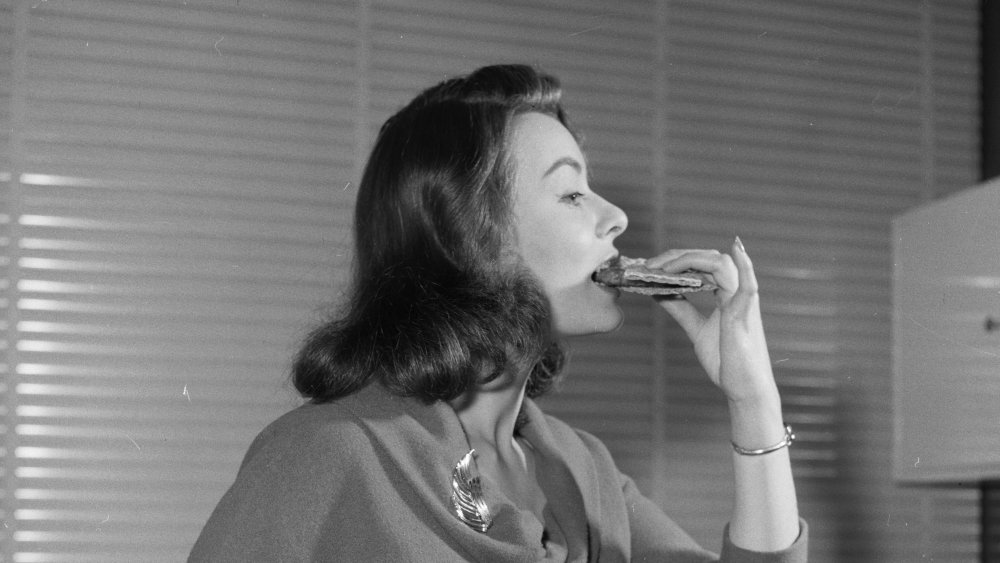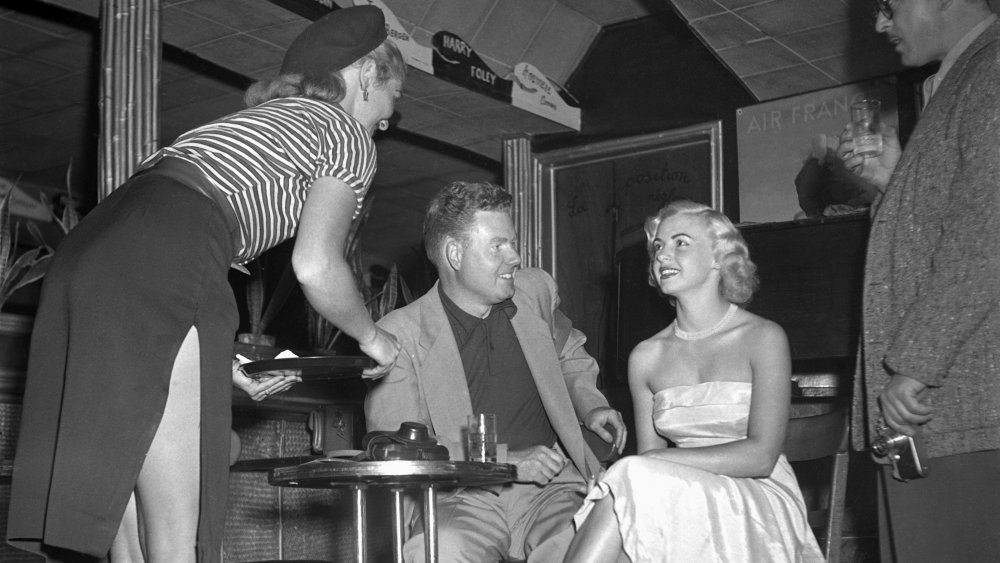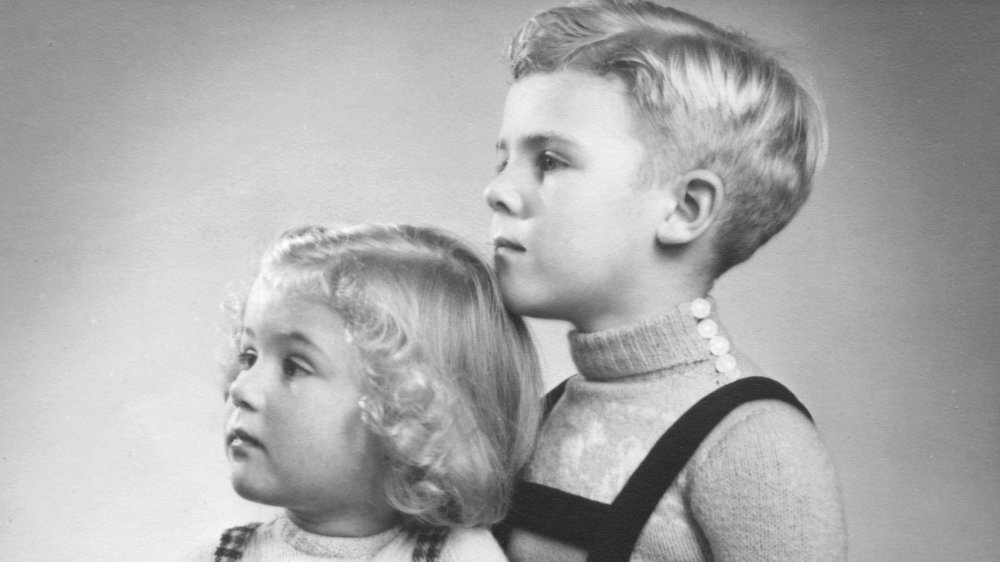Things Americans In The 1950s Couldn't Live Without
Coming out of the Great Depression, followed by the end of WWII, America found itself flourishing. Since families spent so much time rationing during the war, an economic boom suddenly erupted, and with so many inventions centering on day-to-day ease of living, consumerism took center stage. "In postwar America family and daily life underwent phenomenal changes as the United States became the leading world power," writes the Handbook to Life in America, Volume 8. "In the 1950s, daily life for most Americans focused on economic growth and consumption, [and] family life."
After WWII, a misogynist viewpoint was still the norm, and many women opted for lives as homemakers as "men took back the majority of the jobs" available. Wives throughout the country maintained a tight ship in their abodes and miraculously did it at all with a sense of ease. Meanwhile, the men were hard at work, with the postwar years seeing salaries rise exponentially.
So, with all that expendable income, what exactly were people buying? Well, simply put, everything. As Daily Life in 1950s America puts it, "along with rising incomes, easy credit, and fear of being left behind with outmoded products, aggressive marketing in the form of slick advertising campaigns fed the culture of consumerism." While some items found in the average home are still the standard to this day, other fads were just plain bizarre. Let's dig in and find out about the things Americans in the 1950s couldn't live without.
'The Golden Age of Television'
If there's one item that truly encompassed the lives of Americans in the 1950s, it would be the television. "Before 1945, TV simply did not exist as a national phenomenon," writes The Fifties: The Way We Really Were, adding that it was a "clumsy and expensive toy." Although radio once ruled supreme, the tube quickly gained popularity after the war. For reference, "in 1946, 7,000 sets existed in the United States," yet by 1956, "people bought them at an acceleratingly feverish rate — 20,000 a day."
So, what exactly was causing the entire nation to plop down in front of the TV on the regular? As it turns out, many of the shows echoed the ideals of families across the country. According to the Handbook to Life in America, Volume 8, family-friendly shows "garnered enormous profits," such as the immensely popular I Love Lucy or Leave It to Beaver, which "promoted an image of affluent, stable nuclear families." These icons of the small screens always included the homemaker who somehow managed to successfully keep her home spotless "in high heels and jewelry," while children were well-behaved.
While the '50s were dubbed "The Golden Age of Television" (via History), it's also important to realize that besides discussing familial problems, issues of the times such as "poverty, racism, and sex," were off-limits. Along with stereotyping Black people, "there were few old people, no openly acknowledged gays, and no single-parent families."
Americans both young and old owned cars
The accessibility of cars in the 1950s was literally everywhere — and it didn't matter how old you were. "Automobiles increasingly became a part of daily life," notes Handbook to Life in America, Volume 8, adding that "Between 1951 and 1958, the number of families purchasing second cars doubled." Surprisingly enough, even teens could afford their own cars, and since "gasoline was cheap most teenage boys owned their own cars."
These younger car owners relished in their freedom, taking part in bizarre fads such as "seeing how many friends could be stuffed into one small car," or keeping things simple and courting the opposite sex at drive-ins. As Life details, these teens were buying vehicles out of their own pockets — and they weren't old models, either. Dubbed the "Depression Babies" at birth, materialistically, these kids would grow up to be considered "America's luckiest generation."
The 1950s weren't just a heyday of joy rides, however. According to the Handbook to Life in America, "by 1959, the number of automobile-related deaths surpassed the number of Americans killed in all wars to that date." Although that statistic appears startlingly high, perhaps it had something to do with the public "not accept[ing] seat belts, claiming they were a nuisance" (via Second Chance Garage) or flicks like Thunder Road, which promoted drag racing among teenagers.
The radio wasn't going anywhere, thanks to rock 'n' roll
Although the 1950s were "The Golden Age of Television," the radio wasn't going anywhere. Instead, sudden technologies paved the way for future devices to come. Per EDN, In the fall of 1954, the first commercial transistor radio made its debut, groundbreaking as it was truly the start "of a portable audio trend that would include the boombox, the Walkman, CD players, [and] the iPod."
Although the concept was revolutionary, the price tag was still hefty for the times, with these pocket-friendly gadgets costing the public $49.95. Because of this, most folks stuck to using good ole' fashioned radios in their homes — which now had a different focus. As Encyclopedia Britannica notes, due to the explosion of television, "network drama and variety programs" ceased to play on radios, instead "replaced by music-driven local programming." One genre that kept the radio alive? None other than rock 'n' roll.
Rock's popularity grew in the '50s "largely [due] to the efforts of disc jockey Alan Freed," explains the Khan Academy, adding that he'd play it on radio stations in Cleveland. These times also saw the rise of "Top 40" programming, which would help Elvis Presley burst onto the scene with his musical debut in 1956. As Rolling Stone so perfectly summarized in 1990, the '50s were "A Decade of Music That Changed the World," with teens throughout the country "[huddling] under bedroom covers with [their] ears glued to a radio."
Placing food in Jell-O was the norm
We've all seen the gag-worthy photos of gelatin-encased meals from the '50s. While putting foods that don't belong anywhere near Jell-O — such as lamb chops — into the neon-colored, jiggly goo genuinely seems pointless, there actually was a pretty hilarious reason behind it all. According to The Daily Meal, "in the early 1950s refrigerators were still quite expensive, and gelatin needs refrigeration in order to set." This meant that, oddly enough, Jell-O was "something of a status symbol."
With more people buying fridges as time went on, this gelatin craze only grew — in part due to the dignity of housewives. As food historian Laura Shapiro once explained (via Serious Eats), 1950s homemakers prided themselves on making elaborate meals and even shunned instant products, referring to women who prepared them as "lazy" and "disorganized." Sure enough, presenting regular Jell-O was too easy, but encasing entire meals in them? That's the sort of dedication that would even make June Cleaver proud.
Social life in the '50s included countless dinner parties, so the "Perfection Salad" (shredded vegetables in Jell-O) made the ideal centerpiece. Mid-century food blogger Ruth Clark explained this to the National Museum of American History, noting, "There was a lot of rich food, a lot of big parties; food presentation and garnishes were very intricate. Sitting down at the table and having dinner became a cultural phenomenon."
Our soda obsession hasn't changed
There's nothing nicer than a refreshing glass of soda on a warm day, right? According to a 2012 Fox News article, "48 percent of U.S. adults say they drink at least one glass of soda a day," with the average amount being "2.6 glasses a day." As it turns out, not much has changed since the 1950s.
"At home, virtually everyone consumed soft drinks," notes The 1950s. And while that may not seem like a big deal, "between 1952 and 1955, consumption of soft drinks rose by 300 percent" (via Handbook to Life in America, Volume 8). To be fair, while this may seem remarkably unhealthy, it may have had something to do with the availability of these fizzy, sugary delights. Soda fountains were the norm leading up to the '50s, yet at the start of the decade, Walgreens introduced their first-ever "self-serve" soda station — allowing folks to take away their drinks.
As revealed in Sundae Best: A History of Soda Fountains, these self-serve stations weren't the be-all-end-alls of the time, either. Similarly, the '50s also saw the rise of the "take-home" bottled soda, with Pepsi-Cola taking the reins on this "new marketing strategy," as "Coca-Cola had always sold much better than Pepsi at soda fountains." Clearly, to-go bottles of soda were the way of the future, as, by 1967, there were "nearly 1.2 million machines [selling] soft drinks in the United States."
What's more riveting than a Tupperware Party?
Ahh, the girls' night in. These days, it's a perfect excuse to get together with your gals, binge-watch an entire season of The Bachelorette, and drink way too much boxed wine. The '50s, on the other hand, saw the rise of a much different craze — and it usually happened in the day while husbands were away at work. Cue: the Tupperware Party.
Although they were designed to maintain the freshness of your food and cleanliness of your kitchen, consumers were confused about the Tupperware products introduced to the world after WWII (via History). Invented by Earl Tupper, he teamed up with Stanley Home Products, who at the time were successfully selling regular home items "through in-house presentations," as explained by the Handbook to Life in America, Volume 8. With the help of one of Stanley Home's best salespeople, Brownie Wise, the Tupperware Party was born and was received so favorably, "that Tupperware was removed from store shelves and exclusively sold through the parties."
Wise became Tupper's general sales manager in 1951, becoming known for her energetic at-home demonstrations. As History details, "She'd throw the plastic across the room to show that it didn't break, and get friends laughing as they played silly party games that educated them about the product." It was a fine break from the monotonous life of cleaning for housewives, and for Tupper himself, a total success. By 1958, he sold the company for a whopping $16 million.
Home appliances were all the rage
While buying household appliances is obviously still a regular occurrence in modern times, the evolution of suburbia and the concept of domestic bliss were indeed priorities in the 1950s. As SFGate notes, "The popular appliances of the 1950s remain common, in more modern forms, in the homes of today."
So, why was buying appliances such a craze in the '50s? Historian Elaine Tyler May puts it perfectly (via PBS), explaining, "The values associated with domestic spending upheld traditional American concerns," adding, "Purchasing for the home helped alleviate traditional American uneasiness with consumption: the fear that spending would lead to decadence." Instead, items being invested in were beneficial for the family, such as "washing machines, refrigerators, toasters, and vacuum cleaners: the machines that would help them modernize their lives."
These "modern" contraptions were advertised on television, showcasing the perfect nuclear family. One commercial for refrigerators in 1955, for example, presented a fully stocked unit, equipped with the newest additions: ice makers, automatic defrosters, and even lemonade dispensers. Naturally, the "homemaker" in the video was the perfectly put-together Betty Furness, donning an outfit no woman would be caught dead cleaning in during this day and age.
The 'TV Dinner' came to fruition
It's interesting that TV dinners were as popular as they were in the '50s — especially considering the focus on making elaborate (albeit sometimes gross) meals. According to the Library of Congress, the first idea of a basic frozen meal came in 1945, "reheated on the plane for military and civilian airplane passengers." Due to financial reasons, these dinners never made it to the full consumer market, and it's the widespread popularity of another household item that helped start a massive craze.
As the '50s came, there were as many as "four million TV sets in the United States" (via Handbook to Life in America, Volume 8). With "The Golden Age of Television" truly taking over the country, it made sense for manufacturers to suddenly start producing "television-related products" — which is precisely where the TV dinner came into play. "The growing attachment to television led the manufacturer of frozen TV dinners, which could be quickly heated and then eaten before the television set," because why would you ever want to miss an I Love Lucy episode?
In 1954, the already-well-respected Swanson brand really popularized the concept with "a massive advertising campaign for their product" — officially coining the term "TV Dinner, which helped to transform their frozen meals into a cultural icon" (via Library of Congress).
Everyone smoked cigarettes, even doctors!
"If you were to follow a busy doctor as he makes his daily round of calls, you'd find yourself having a mighty busy time keeping up with him. Time out for many men of medicine usually means just long enough to enjoy a cigarette." Has this statement ever rung true? Well, in the 1950s, it did, and this Camel smoking ad assured people that if medical professionals did it, it must be safe, right?
Per The Guardian, smoking in the 1950s was perceived as "the epitome of cool and glamour." Everyone did it, including "Hollywood icons such as James Dean and Humphrey Bogart," while ads were filled with now-shocking images, like cartoon characters, children — or even Santa Claus himself. Simply put, "By the late 1950s around half of the population of industrialized nations smoked." According to The New York Times, a countless amount of "doctors, dentists, and nurses" were featured in these campaigns, "making statements that are now known to be patently untrue," such as, "Not one single case of throat irritation due to smoking Camels!" Uh... right.
While people puffed away at their illusions of glitz and glam, it's only in 1964 that it became disturbingly clear that smoking wasn't healthy — causing the U.S. Surgeon General to announce a "definitive link between smoking and cancer" (via History).
Pray, vibrate, or even eat your fat away
Our obsession with dieting has never really gone away. These days, images of social media influencers promoting diet teas are the total norm, yet in the '50s, weight loss techniques were even more bizarre. Whatever happened to good old-fashioned cardio?
In post-war America, the diet craze really took off, particularly with women, who "felt it was unfeminine" to partake in strenuous exercise (via Daily Life in 1950s America). Instead, downright weird techniques came into play, such as the "prayer" diet, which consisted of attempting to pray your pounds away. If that didn't work, you always had the unfortunately-named AYDS "vitamin candy," which promised to "help users lose 10 pounds in five days without dieting or exercise," enlisting celebs to push the product in marketing campaigns, too. After you've prayed and taken your weight-loss sweets, if those didn't work, you always had your gimmicky quick fixes, such as "stomach rollers [or] the vibrating belt," which, naturally, did nothing but made you look like a vibrating mess.
Since everything absolutely revolved around television in the '50s, fitness celebrities became popular during this time, such as The Jack LaLanne Show, which promoted using "basic objects around the house, like a chair," to get your exercise in. As The 1950s notes, this decade also saw supermarkets begin to cater to dieters, like the introduction of sugarless products such as gum, Sweet 'N' Low, and "No-Cal Ginger Ale [...] the first of the sugar-free soft drinks."
Cocktails were the new drinks of choice
If you weren't reaching for a cold, refreshing glass of Coca-Cola, the next bet for a drink of choice in the '50s involved liquor — hard liquor. "Consumption of liquor in general rose from 190 million gallons to 235 million gallons between 1950 and 1960," writes The 1950s noting that vodka consumption, for example, rose "from virtually nothing to 9 million gallons produced in 1959."
Of course, like most trends of the times, Hollywood helped push this craze, using alcohol to add "mystique surrounding liquor, fashion, and elegance." One type of drink that truly oozed style and class? The cocktail. Beverages such as the Manhattan, martini (thanks, James Bond), or an old fashioned were all potent mixes, poising themselves as "status drinks," with the term "cocktail time" becoming a common phrase.
"An entire culture [evolved] around cocktails in the 1950s," notes Daily Life in 1950s America, listing off the fads that consisted of "cocktail hour, cocktail parties, cocktail dresses," and the like. Perhaps writer Susan Cheever put it best in 2016, declaring that the 1950s were "awash in alcohol."
Babies, babies, babies!
Nowadays, Gen Z and Millennials relish in the opportunity to cry out, "OK, Boomer," whenever they want to air out their frustrations at an older generation. That being said, what exactly are Boomers? Well, to put it simply, the word "Boomer" is a shortened version of "Baby Boomer," the demographic of individuals born between the late-'40s and mid-'60s.
It turns out, the 1950s saw the highest amount of births to date after WWII — dubbing it the "Baby Boom." As the Khan Academy notes, every year between 1946 to 1964, an "average [of] 4.24 million new babies" were added "to the population" — all due to the sudden flourishing post-war economy. Babies influenced family life tremendously (and in turn, consumerism), with the suburban white-picket-fence becoming what was known as "The American Dream."
With families suddenly growing everywhere in America, Boomers suddenly had countless products being developed and marketed to them, and as the Handbook to Life in America, Volume 8 reveals, these houses in the 'burbs had their yards filled with children's objects like "swing sets, sandboxes, tricycles, bicycles, balls, bats, frisbees, and hula hoops."
Jaw-droppingly enough, by the time the '60s rolled around, "90.9 percent of all American families contained at least one child." No wonder there's so many to complain about these days, huh?
